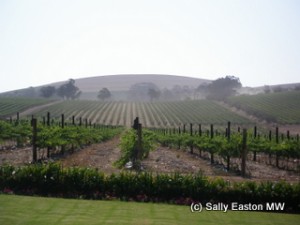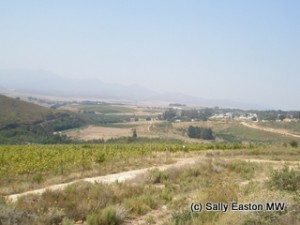Bright, young South African wine industry
Viticulture in South Africa may have started 350 years ago in 1659 when the first wine was made from grapes grown in the Cape, but South Africa is in the grips of a rejuvenating revolution that was kick-started with the arrival of democracy in 1994.
Democracy liberated the industry from the shackles of the past including trade sanctions, which also meant that high quality new planting material was hard to come by, and a brandy-distillation focused grape growing trade, rather than light wine. International travel, the lifeblood of cross-fertilisation of ideas and skills in a global wine industry had also been inhibited prior to democracy.
A defining moment occurred two years prior to democracy with the ending of the quota system.

Cederberg vineyards
To backtrack momentarily, at the turn of the 20th century, the South African wine industry was in poor state of affairs with both wine surplus and attacks of devastating phylloxera. So in 1918, the KWV co-operative was set up to stabilise the industry. A quota system was later introduced which limited the number of vines a producer could grow. This meant the KWV, as operators of the quota, controlled the size of crop, the grape varieties planted, and the location of grapes. It was not something that encouraged quality improvement, because minimum prices were guaranteed for grape products.
Abandoning the quota system in 1992 allowed a freer market to develop. Vines could be planted anywhere someone thought they could successfully make wine. The playing field was levelled further in 1997, when the KWV was privatised.
As a result, in the last 15 years, new wine-growing regions have been popping up all over the place in the Cape, outside the traditional areas of Stellenbosch, Paarl, Constantia and Robertson. For example, Cederberg, high up in the mountains; Lambert’s Bay, tight against the Atlantic coast; Elim, tight on the Indian Ocean; and further along the Indian Ocean coast, Plettenberg Bay, a good 500km as the crow flies from Cape Town.
Generally, given that South Africa has a warm to hot Mediterranean climate, growers have sought less warm areas, and apple-growing territory such as that at Elgin, was an early opportunity. Those coastal pockets up the Atlantic and across the Indian Oceans are proving increasingly popular.
As a result of the shifting vineyards, the number of Wine of Origin (WO) designations has doubled since 1990, now heading towards 100. The WO system specifies that fruit must come from the origin stated on the label, providing a guarantee of origin to consumers, much as the appellation system does in Europe.
Yet all this flight from traditional areas has not seen a massive expansion in vineyard area. Over the last five years the total vineyard area has settled at just over 100,000 hectares (ha). France, by comparison has 825, 000 ha, Australia 174,000 ha.

Diemersdal
However the structure of the country’s vineyard has changed almost beyond recognition, in terms of the grape varieties planted and the age of the vines. Twenty years ago, white grapes accounted for 85% of the vineyard area. Now they account for just 56% as red grapes have taken firm root in the Cape. The top four reds – cabernet sauvignon, shiraz, merlot and pinotage between them are 35% of the total vineyard, though in the last few years only shiraz plantings are still growing, and then only just. Cabernet sauvignon plantings have increased three-fold, and shiraz plantings have gone from a just 1% 20 years ago to 10% today, an extraordinary increase, but one well borne-out by the warm and hot Mediterranean climate that favours shiraz/syrah. Even merlot plantings have doubled in the last decade.
On the white front, chenin blanc, which in 1990 represented a third of the vineyard area, is now less than 20%. And very much flavour of the moment, sauvignon blanc, plantings have doubled to nearly 10%. It is the historical, less good quality grape varieties that are being ripped out, the likes of crouchen, palomino, clairette, and lesser known varieties, to make way for international grape varieties that have a considerably better export potential.
All this uprooting and replanting in recent years means about 50% of the South Africa’s vineyard is less than 10 years old, which by old world standards, is thought to be significant tipping point for improved wine quality. So things augur well for those producers already doing well from their young fruit.
A decade ago, the buzz was around Cape Blends – usually Bordeaux blends (cabernet sauvignon/merlot) with some of the Cape’s indigenous pinotage blended in. Warwick Estate’s Three Cape Ladies (the current 2005 vintage being 38% cabernet sauvignon; 25% pinotage; 22% shiraz and 15% merlot) is one of my favourite examples of the genre.
Now, the buzz is all around pristine, grassy-tropical-combo sauvignon blanc from relatively cooler, coastal sites, as well as around different expressions of shiraz/syrah, according to location. There’s been some ‘rediscovery’ of older vineyard pockets, for example around Paardeberg and Malmesbury in Swartland, about 70km north and a tad east of Cape Town, where the likes of Sadie Family Vinyards, Scali, The Observatory and Lammershoek lie, alongside the Swartland co-op which has being going for more than 60 years.

Luddite, Bot River
Additionally the opening up of newer, less warm, sites is offering a stylistic difference, with more black pepper spice notes, floral violets and blackcurrant fruit. Cederberg first planted shiraz in 1999 and have developed a nice reputation for theirs. Diemersdal in Durbanville have a good commercial version. Luddite in Walker Bay only makes shiraz and their 2005 is a big, nicely-structured wine. It’s still evolving, but some producers are adopting the ‘syrah’ moniker for the ‘cooler’ examples and ‘shiraz’ for the warmer, full-blooded versions.
So much else is still evolving in viticulturally emancipated South Africa.
This article was inspired by a visit to the region in March 2009 sponsored by Wines of South Africa.
Comments
One Response to “Bright, young South African wine industry”




November 10, 2009 at 5:06 pm
Very interesting and insightful article.